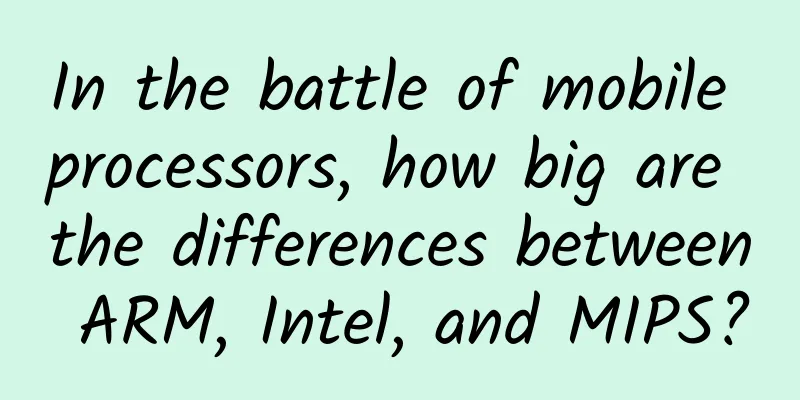In the battle of mobile processors, how big are the differences between ARM, Intel, and MIPS?

|
Android supports three types of processors (CPUs): ARM, Intel, and MIPS. ARM is undoubtedly the most widely used. Intel is well known for its popularity in desktops and servers, but has relatively little influence in the mobile industry. MIPS has a long history in the 32-bit and 64-bit embedded fields and has achieved a lot of success, but Android has the lowest adoption rate among the three. In short, ARM is the winner now and Intel is ARM's strongest opponent. So what is the difference between ARM processors and Intel processors? Why is ARM so popular? Does it matter what processor your smartphone or tablet uses? Processor (CPU) The central processing unit (CPU) is the brain of your smart device. Its job is to drive your device by executing a series of instructions, including the display, touch screen, modem, etc., turning a piece of plastic and metal into a shiny smartphone or tablet. Mobile devices are very complex, and the processors in them need to execute millions of lines of instructions to do what people want these devices to do. Speed and power consumption are crucial for processors. Speed affects the user experience, and power consumption affects battery life. The perfect mobile device must have good performance and low power consumption. This is why it is important to choose the right processor. A super power hungry, slow processor will drain your battery quickly, while a sophisticated, efficient processor will give you high performance and long battery life. In general, the first difference between ARM and Intel processors is that the former uses a reduced instruction set (RISC) while the latter uses a complex instruction set (CISC). In layman's terms, a RISC is smaller and more atomic, while a CISC is larger and more complex. Atomic operations mean that the work of each instruction can be mostly done by the processor in one operation, such as adding two registers. CISC instructions describe an intention, but the processor must execute 3 or 4 simpler instructions to achieve this intention. For example, a CISC processor can be commanded to add 2 numbers and store the result in main memory. To complete this command, the processor first gets the first number from address 1 (operation 1), then gets the other number from address 2 (operation 2), then adds them (operation 3), and so on. All modern processors use a concept called microinstructions , which is a set of instructions inside the processor that describe the atomic operations that the processor can do. The RISC processor actually executes 3 microinstructions. For RISC processors, the instructions are very close to the microinstructions, while the RISC instructions need to be converted into some more compact microinstructions first (just like the RISC processor addition example above). This means that the decoder (the thing that tells the processor what to do) in the RISC processor is much simpler, and simplicity means efficiency and low power consumption. Manufacturing process Another major difference between ARM and Intel processors is that ARM has always designed low-power processors. Their mission is to design low-power processors, which is their strength. Intel's strength is to design ultra-high-performance desktop and server processors, and they do it well. Intel is the leader in the desktop and server industry. All my PCs, laptops, and servers (except one) for the past 20 years have Intel processors. However, when Intel entered the mobile industry, it still used the same complex instruction set architecture as the desktop and tried to squeeze it into a smaller processor for mobile devices. The average Intel i7 processor heats up 45 watts. The maximum instantaneous peak heat rate of an ARM-based system-on-chip (including a graphics processor) is about 3 watts, which is about 1/15 of that of an Intel i7 processor. Intel is now a giant and employs a lot of smart people. Its latest Atom series processors use a similar thermal control design as ARM processors, which requires Intel to use the latest 22-nanometer manufacturing process. Generally speaking, the smaller the number of nanometers in a manufacturing process, the more efficient it is in using energy. ARM processors use a lower manufacturing process and have similar thermal control effects. For example, Qualcomm's Snapdragon 805 processor uses a 28-nanometer manufacturing process. 64-bit There are also some significant differences between ARM and Intel when it comes to 64-bit computing. Did you know that Intel did not develop a 64-bit version of the x86 instruction set? This 64-bit instruction set, called x86-64 (sometimes shortened to x64), was actually designed and developed by AMD. Here's the story: Intel wanted to do 64-bit computing, and it knew that if it evolved a 64-bit architecture from its 32-bit x86 architecture, the new architecture would be very inefficient, so it created a new 64-bit processor project called IA64. This led to the Itanium family of processors. AMD also knew it couldn't make a processor that was compatible with IA64, so it extended x86 to include 64-bit addressing and 64-bit registers. The resulting architecture, known as AMD64, became the standard for 64-bit versions of x86 processors. The IA64 project was not a success and is now largely abandoned. Intel eventually adopted AMD64. Intel's current mobile offering is a 64-bit processor that uses the 64-bit instruction set developed by AMD (with some differences). ARM's story is very different: seeing the need for 64-bit computing in mobile devices, ARM released the ARMv8 64-bit architecture in 2011, which was the culmination of several years of work on the next generation of the ARM instruction set architecture. In order to develop a simple 64-bit architecture based on the original principles and instruction set, ARMv8 uses two execution modes, AArch32 and AArch64. As the names suggest, one runs 32-bit code and the other runs 64-bit code. The clever thing about ARM's design is that the processor can seamlessly switch between the two modes while running. This means that the decoder for 64-bit instructions is completely redesigned, without having to take into account 32-bit instructions, while the processor is still backward compatible. ARM's big.LITTLE architecture is an innovation that Intel can't replicate for a while. In big.LITTLE, processors can be of different types. Traditional dual-core or quad-core processors contain two or four identical cores. A dual-core Atom processor has two identical cores that provide the same performance and the same power consumption. With big.LITTLE, ARM is bringing heterogeneous computing to mobile devices. This means that the cores in the processor can have different performance and power consumption. When the device is running normally, the low-power cores are used, and when you are running a complex game, the high-performance cores are used. How is this done? When designing a processor, a large number of technical designs must be considered, which determine the performance and power consumption of the processor. When an instruction is decoded and prepared for execution, both Intel and ARM processors use pipelines. This means that the decoding process is parallel. The first step is to read the instruction from memory, the second step is to check and decode the instruction, and the third step is to execute the instruction, and so on. The advantage of pipelines is that when the current instruction is in the second step, the next instruction is already in the first step. While the current instruction is executing in step 3, the next instruction is in step 2, and the next instruction is in step 1, and so on. To execute instructions faster, these pipelines can be designed to allow instructions to be executed out of order (out-of-order execution). Some clever logic structures can determine whether the next instruction depends on the result of the current instruction. Intel and ARM both provide out-of-order execution logic structures, which are, as you can imagine, very complex. Complexity means more power consumption. Intel processors are designed to choose whether to add out-of-order logic structures. Heterogeneous computing does not have this convenient problem. ARM Cortex-A53 uses sequential execution, so it consumes less power. ARM Cortex-A57 uses out-of-order execution, so it is faster but more power-hungry. Processors using the big.LITTLE architecture can have both Cortex-A53 and Cortex-A57 cores, and decide how to use these cores according to specific needs. When syncing emails in the background, you don't need high-speed out-of-order execution, but only when playing complex games. Use the right core at the right time. In principle, the more complex logic structures in a processor, the higher the performance, and the less complex logic structures in a processor, the higher the efficiency. The instruction pipeline is just one of them, including floating point units, single instruction multiple data logic (SIMD) (such as ARM's NEON and Intel's SSE/MMX), and L1 cache and L2 cache. Intel only provides one solution for each Atom system-on-chip, while chips provided by ARM and its chip partners can be configured in multiple solutions. Compatibility ARM is currently the leader in mobile processors. ARM's partners have shipped 50 billion chips based on ARM designs to the mobile and embedded markets. For Android, ARM has become the standard, which is a problem for Intel and MIPS. Although the main programming language of Android is Java, developers can also use existing code (such as C or C++) to develop applications. These fixed-platform applications are usually compiled into programs for ARM processors, not all of them are compiled into programs for Intel or MIPS processors. To solve this problem, Intel and MIPS have to use special conversion software to convert ARM instructions into instructions used by their processors. This will of course reduce performance. Currently, MIPS and Intel claim to be compatible with about 90% of the applications in the Play Store. For the most popular 150 apps, the compatibility rate is 100%. This is a high compatibility rate, but it also shows that ARM is so dominant that other processor designers need to provide a compatibility layer. Conclusion Making processors is a complex business. ARM, Intel, and MIPS are all working hard to provide the best technology for mobile devices, and ARM is clearly the leader. With low power consumption, simple 64-bit design, heterogeneous computing, and being the standard for mobile computing, it seems that ARM will be able to maintain its position as the leader. As a winner of Toutiao's Qingyun Plan and Baijiahao's Bai+ Plan, the 2019 Baidu Digital Author of the Year, the Baijiahao's Most Popular Author in the Technology Field, the 2019 Sogou Technology and Culture Author, and the 2021 Baijiahao Quarterly Influential Creator, he has won many awards, including the 2013 Sohu Best Industry Media Person, the 2015 China New Media Entrepreneurship Competition Beijing Third Place, the 2015 Guangmang Experience Award, the 2015 China New Media Entrepreneurship Competition Finals Third Place, and the 2018 Baidu Dynamic Annual Powerful Celebrity. |
>>: Why is the CPU frequency of Xiaomi 5, which costs 1999 yuan, so low?
Recommend
How to build user portraits, 4 methods!
As a very common design tool, user portraits alre...
Quantitative Science Lecture Hall Jincheng Li Yamin Quantitative Science Dragon Catching No. 26
The Quantitative Science Lecture Hall Jincheng Li...
Yan Ning's students talk about: What should I do if I want to give up my doctoral studies? What path should I choose after graduation?
The Women in Science Forum is now in its seventh ...
Can China's Yongle Palace murals, which are as large as 1,000 square meters, be restored by AI?
Nowadays, artificial intelligence (AI) is not onl...
How much does it cost to create an e-book applet in Yingkou?
How much does it cost to join the Yingkou e-book ...
Are feet a "monitor" of blood sugar? If your feet show these 6 symptoms, it may indicate that your blood sugar is above the standard
The feet can be said to be a magnifying glass for...
Tesla released its Q3 2020 financial report, with net profit reaching US$331 million, a year-on-year increase of 131%
In the past two years, with Tesla's vigorous ...
What are the new changes in Beijing's new energy vehicle subsidy standards?
On February 17, 2017, Beijing Municipal Science a...
Price inquiry for customized Yueyang decoration mini program. How much does customized Yueyang decoration mini program cost?
In order to better penetrate into various industr...
Is the wind on the Qinghai-Tibet Plateau really “weak and powerless”?
Qinghai-Tibet Plateau It is one of the three majo...
A large wave of spam animations is coming
Source code introduction: Compared with the previ...
How much does it cost to develop the Haixi Toys mini program? How much is the price for developing Haixi Toys Mini Program?
The launch of mini programs has brought convenien...
6 people, 6 cabins, 6 months, 666 my Chinese space station!
With the successful docking of the Shenzhou-15 ma...
After taking over the channel for 5 months, I figured out all the free promotion routines in the Android market...
The matter began with a platform turnover statist...
China National Radio: BAIC Motors, ignoring safety
China National Radio, Beijing, January 12 (Report...









